Bounded-Error-Pruned Sensor Data Compression for Energy-Efficient IoT of Environmental Intelligence
Abstract
1. Introduction
2. Related Works
3. Bounded-Error Sensor Data Compression (BESDC)
3.1. Basic Processing Flow
3.2. EB-RLE, EB-HC and Spatial Correlation Compression
3.3. EB-HC
3.4. Spatial Correlation Compression
4. Experimental Results and Performance Evaluations
4.1. Two-Tier BEA
4.2. Calculations of Compression and Energy Consumption Ratios for BESDC
4.3. Performance Improvement from Temporal and Data Correlation Compression
4.4. Performance Improvement from Spatial Correlation Compression
5. Conclusions and Future Work
Author Contributions
Funding
Conflicts of Interest
References
- Alloulah, M.; Huang, H. Future Millimeter-Wave Indoor Systems: A Blueprint for Joint Communication and Sensing. Computer 2019, 52, 16–24. [Google Scholar] [CrossRef]
- Savazzi, S.; Sigg, S.; Vicentini, F.; Kianoush, S.; Findling, R. On the Use of Stray Wireless Signals for Sensing: A Look Beyond 5G for the Next Generation of Industry. Computer 2019, 52, 25–36. [Google Scholar] [CrossRef]
- Satyanarayanan, M.; Davies, N. Augmenting Cognition Through Edge Computing. Computer 2019, 52, 37–46. [Google Scholar] [CrossRef]
- Gao, N.; Shao, W.; Salim, F.D. Predicting Personality Traits from Physical Activity Intensity. Computer 2019, 52, 47–56. [Google Scholar] [CrossRef]
- Tariq, N.; Asim, M.; Al-Obeidat, F.; Farooqi, M.Z.; Baker, T.; Hammoudeh, M.; Ghafir, I. The Security of Big Data in Fog-Enabled IoT Applications Including Blockchain: A Survey. Sensors 2019, 19, 1788. [Google Scholar] [CrossRef]
- Gill, S.S.; Tuli, S.; Xu, M.; Singh, I.; Singh, K.V.; Lindsay, D.; Tuli, S.; Smirnova, D.; Singh, M.; Jain, U.; et al. Transformative effects of IoT, Blockchain and Artificial Intelligence on cloud computing: Evolution, vision, trends and open challenges. Internet Things 2019, 8, 100118. [Google Scholar] [CrossRef]
- Nabeeh, N.A.; Abdel-Basset, M.; El Ghareeb, H.A.; Aboelfetouh, A. Neutrosophic Multi-Criteria Decision Making Approach for IoT-Based Enterprises. IEEE Access 2019, 7, 59559–59574. [Google Scholar] [CrossRef]
- Fang, S.; Da Xu, L.; Zhu, Y.; Ahati, J.; Pei, H.; Yan, J.; Liu, Z. An Integrated System for Regional Environmental Monitoring and Management Based on Internet of Things. IEEE Trans. Ind. Inform. 2014, 10, 1596–1605. [Google Scholar] [CrossRef]
- Li, N.; Sun, M.; Bi, Z.; Su, Z.; Wang, C. A new methodology to support group decision-making for IoT-based emergency response systems. Inf. Syst. Front. 2013, 16, 953–977. [Google Scholar] [CrossRef]
- Koubaa, A.; Severino, R.; Alves, M.; Tovar, E. Improving Quality-of-Service in Wireless Sensor Networks by Mitigating “Hidden-Node Collisions”. IEEE Trans. Ind. Inform. 2009, 5, 299–313. [Google Scholar] [CrossRef]
- Wang, Y.J. Study on Physical Air Temperature Measurement. Available online: http://photino.cwb.gov.tw/rdcweb/lib/cd/cd07mb/MB/PDF/40/No.1/01.pdf (accessed on 31 October 2019).
- Chang, R.-I.; Li, M.-H.; Chuang, P.; Lin, J.-W. Bounded-error Data Compression and Aggregation in Wireless Sensor Networks. In Smart Sensors Networks; Academic Press: Cambridge, MA, USA, 2017; pp. 143–157. [Google Scholar]
- Biligin, A.; Marcellin, M.W.; Altbach, I. Compression of electrocardiogram signals using JPEG2000. IEEE Trans. Consum. Electron. 2003, 49, 833–840. [Google Scholar] [CrossRef]
- Liu, H.S.; Chuang, C.C.; Lin, C.C.; Chang, R.I.; Wang, C.H.; Hsieh, C.C. Data compression for energy efficient communication on ubiquitous sensor networks. J. Appl. Sci. Eng. 2011, 14, 245–254. [Google Scholar]
- Lin, C.C.; Chuang, C.C.; Chiang, C.W.; Chang, R.I. A novel data compression method using improved JPEG-LS in wireless sensor networks. In Proceedings of the 12th International Conference on Advanced Communication Technology (ICACT) IEEE, Phoenix Park, Korea, 7–10 February 2010; Volume 1, pp. 346–351. [Google Scholar]
- Bendifallah, A.; Benzid, R.; Boulemden, M. Improved ECG compression method using discrete cosine transform. Electron. Lett. 2011, 47, 87. [Google Scholar] [CrossRef]
- Chen, J.; Ma, J.; Zhang, Y.; Shi, X. A Wavelet-Based ECG Compression Algorithm Using Golomb Codes. In Proceedings of the 2006 International Conference on Communications, Circuits and Systems, Guilin, China, 25–28 June 2006; Institute of Electrical and Electronics Engineers (IEEE): New York, NY, USA; Volume 1, pp. 130–133. [Google Scholar]
- Fang, J.; Li, H. Hyperplane-Based Vector Quantization for Distributed Estimation in Wireless Sensor Networks. IEEE Trans. Inf. Theory 2009, 55, 5682–5699. [Google Scholar] [CrossRef]
- Wang, Y.-C.; Hsieh, Y.-Y.; Tseng, Y.-C. Multiresolution Spatial and Temporal Coding in a Wireless Sensor Network for Long-Term Monitoring Applications. IEEE Trans. Comput. 2009, 58, 827–838. [Google Scholar] [CrossRef]
- Kawahara, M.; Chiu, Y.-J.; Berger, T. High-speed software implementation of Huffman coding. In Proceedings of the DCC’98 Data Compression Conference (Cat. No. 98TB100225), Snowbird, UT, USA, 30 March–1 April 1998; p. 553. [Google Scholar]
- Marcelloni, F.; Vecchio, M. A Simple Algorithm for Data Compression in Wireless Sensor Networks. IEEE Commun. Lett. 2008, 12, 411–413. [Google Scholar] [CrossRef]
- Javed, M.Y.; Nadeem, A. Data compression through adaptive Huffman coding schemes. In Proceedings of the 2000 TENCON Proceedings Intelligent Systems and Technologies for the New Millennium (Cat. No.00CH37119), Kuala Lumpur, Malaysia, 24–27 September 2000; Institute of Electrical and Electronics Engineers (IEEE): New York, NY, USA. [Google Scholar]
- Tharini, C.; Ranjan, P.V. Design of Modified Adaptive Huffman Data Compression Algorithm for Wireless Sensor Network. J. Comput. Sci. 2009, 5, 466–470. [Google Scholar] [CrossRef][Green Version]
- Huang, N.Y.; Lin, C.C.; Chuang, C.C.; Chang, R.I. Lossless compression for low correlation data in wireless sensor networks. In Proceedings of the Workshop on Wireless Ad Hoc and Sensor Network, Wisla, Poland, 18–20 October 2010. [Google Scholar]
- Luo, H.; Liu, Y.; Das, S.K. Routing Correlated Data with Fusion Cost in Wireless Sensor Networks. IEEE Trans. Mob. Comput. 2006, 5, 1620–1632. [Google Scholar] [CrossRef]
- Luo, H.; Luo, J.; Liu, Y.; Das, S.K. Adaptive Data Fusion for Energy Efficient Routing in Wireless Sensor Networks. IEEE Trans. Comput. 2006, 55, 1286–1299. [Google Scholar] [CrossRef]
- Kumar, R.; Wolenetz, M.; Agarwalla, B. DFuse: A framework for distributed data fusion. In Proceedings of the 1st International Conference on Embedded Networked Sensor Systems, Los Angeles, CA, USA, 5–7 November 2003; pp. 114–125. [Google Scholar]
- Jin, G.-Y.; Park, M.-S. CAC: Context Adaptive Clustering for Efficient Data Aggregation in Wireless Sensor Networks; Springer Science and Business Media LLC: Berlin/Heidelberg, Germany, 2006; Volume 3976, pp. 1132–1137. [Google Scholar]
- Lee, S.; Yoo, J.; Chung, T. Distance-based energy efficient clustering for wireless sensor networks. In Proceedings of the 29th Annual IEEE International Conference on Local Computer Networks LCN-04, Washington, DC, USA, 16–18 November 2004; Institute of Electrical and Electronics Engineers (IEEE): New York, NY, USA. [Google Scholar]
- Yoon, S.; Shahabi, C. The Clustered AGgregation (CAG) technique leveraging spatial and temporal correlations in wireless sensor networks. ACM Trans. Sens. Netw. 2007, 3, 3. [Google Scholar] [CrossRef]
- Goel, S.; Imielinski, T. Prediction-based monitoring in sensor networks. ACM SIGCOMM Comput. Commun. Rev. 2001, 31, 82–98. [Google Scholar] [CrossRef]
- Choi, K.; Kim, M.-H.; Chae, K.; Park, J.-J.; Joo, S.-S. An efficient data fusion and assurance mechanism using temporal and spatial correlations for home automation networks. IEEE Trans. Consum. Electron. 2009, 55, 1330–1336. [Google Scholar] [CrossRef]
- Makarenko, A.; Whyte, H.D. Decentralized data fusion and control in active sensor networks. In Proceedings of the International Conference on Information Fusion, Stockholm, Sweden, 28 June–1 July 2004. [Google Scholar]
- Yuan, W.; Krishnamurthy, S.V.; Tripathi, S.K. Synchronization of multiple levels of data fusion in wireless sensor networks. In Proceedings of the Global Telecommunications Conference, Dallas, TX, USA, 29 November–3 December 2004. [Google Scholar]
- Sharaf, M.A.; Beaver, J.; Labrinidis, A.; Chrysanthis, P.K. TiNA: A scheme for temporal coherency-aware in-network aggregation. In Proceedings of the 3rd ACM International Workshop on Data Engineering for Wireless and Mobile Access, San Diego, CA, USA, 19 September 2003; pp. 69–76. [Google Scholar]
- Lin, C.-L.; Tsai, J.-H.; Chu, Y.-H.; Chang, R.-I. Concept of bounded error to improve wireless sensor network data compression. In Proceedings of the IEEE SENSORS 2014, Valencia, Spain, 2–5 November 2014; IEEE: Piscataway, NJ, USA, 2014; pp. 1240–1243. [Google Scholar]
- Li, M.-H.; Lin, C.-C.; Chuang, C.-C.; Chang, R.-I. Error-Bounded Data Compression Using Data, Temporal and Spatial Correlations in Wireless Sensor Networks. In Proceedings of the 2010 International Conference on Multimedia Information Networking and Security, Nanjing, China, 4–6 November 2010; Institute of Electrical and Electronics Engineers (IEEE): New York, NY, USA; pp. 111–115. [Google Scholar]
- Chen, Y.-H.; Huang, N.-Y.; Chu, Y.-H.; Li, M.-H.; Chang, R.-I.; Wang, C.-H. Dynamic bounded-error data compression and aggregation in wireless sensor network. In Proceedings of the 2012 IEEE Sensors, Taipei, Taiwan, 28–31 October 2012; Institute of Electrical and Electronics Engineers (IEEE): New York, NY, USA; pp. 1–4. [Google Scholar]
- Azar, J.; Makhoul, A.; Barhamgi, M.; Couturier, R. An energy efficient IoT data compression approach for edge machine learning. Futur. Gener. Comput. Syst. 2019, 96, 168–175. [Google Scholar] [CrossRef]
- Agarwal, S.; Mozafari, B.; Panda, A.; Milner, H.; Madden, S.; Stoica, I. BlinkDB: Queries with bounded-errors and bounded response times on very large data. In EuroSys ’13: Proceedings of the 8th ACM European Conference on Computer Systems, Prague, Czech Republic, 14–17 April 2013; ACM: New York, NY, USA, 2003; pp. 29–42. [Google Scholar]
- Hellerstein, J.M.; Haas, P.J.; Wang, H.J. Online aggregation. ACM SIGMOD Rec. 1997, 26, 171–182. [Google Scholar] [CrossRef]
- Di, S.; Cappello, F. Fast Error-Bounded Lossy HPC Data Compression with SZ. In Proceedings of the 2016 IEEE International Parallel and Distributed Processing Symposium (IPDPS), Chicago, IL, USA, 23–27 May 2016; pp. 730–739. [Google Scholar]
- Taiwan Air Quality Monitoring Network. Available online: https://taqm.epa.gov.tw/taqm/en/ (accessed on 1 February 2019).
- U.S. Geological Survey: Earthquake Hazards Program. Available online: http://earthquake.usgs.gov/ (accessed on 1 February 2019).
- Liang, Y.; Peng, W. Minimizing energy consumptions in wireless sensor networks via two-modal transmission. ACM SIGCOMM Comput. Commun. Rev. 2010, 40, 12–18. [Google Scholar] [CrossRef]
- Habib, A.; Moh, S. Game theory-based Routing for Wireless Sensor Networks: A Comparative Survey. Appl. Sci. 2019, 9, 2896. [Google Scholar] [CrossRef]
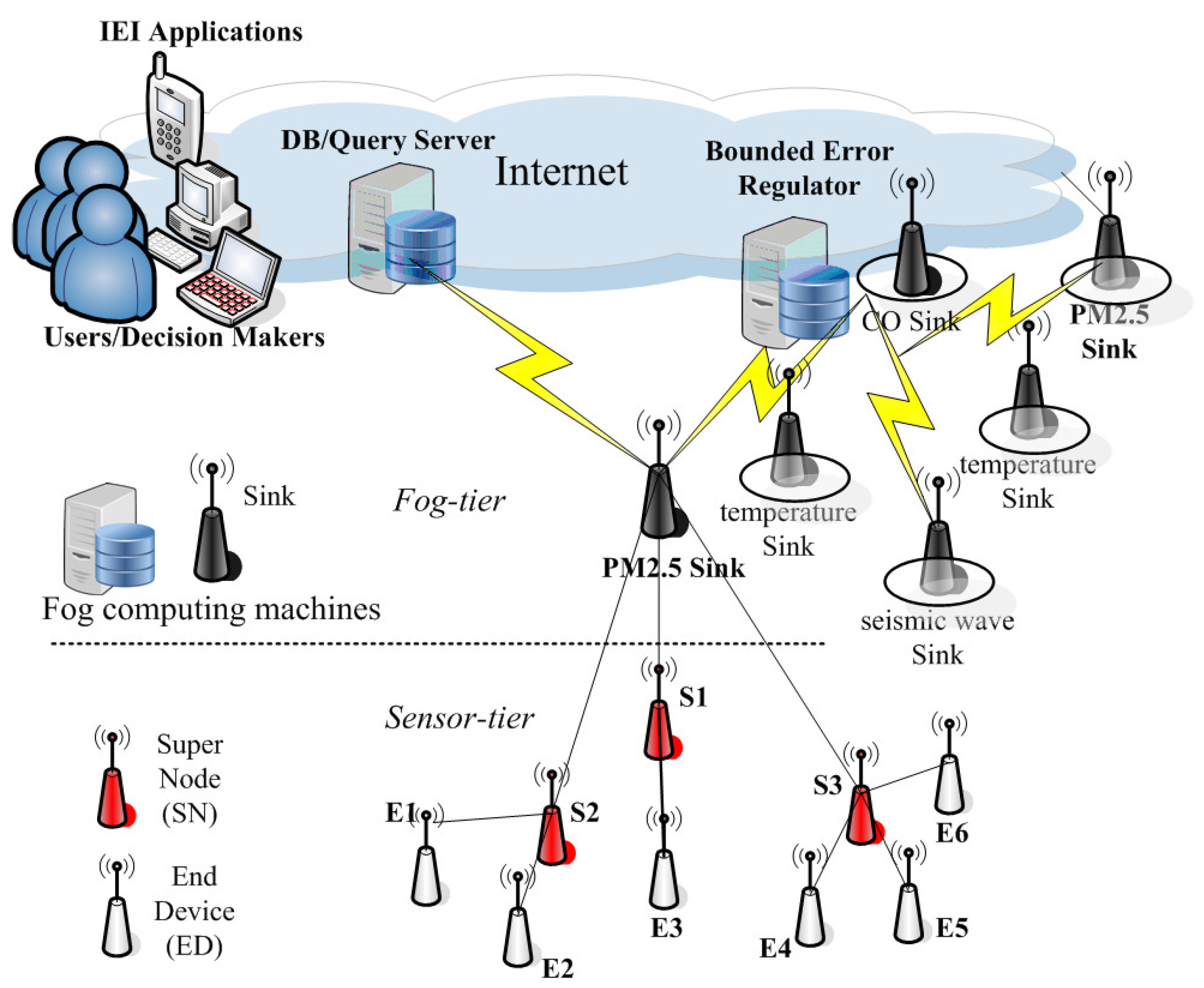

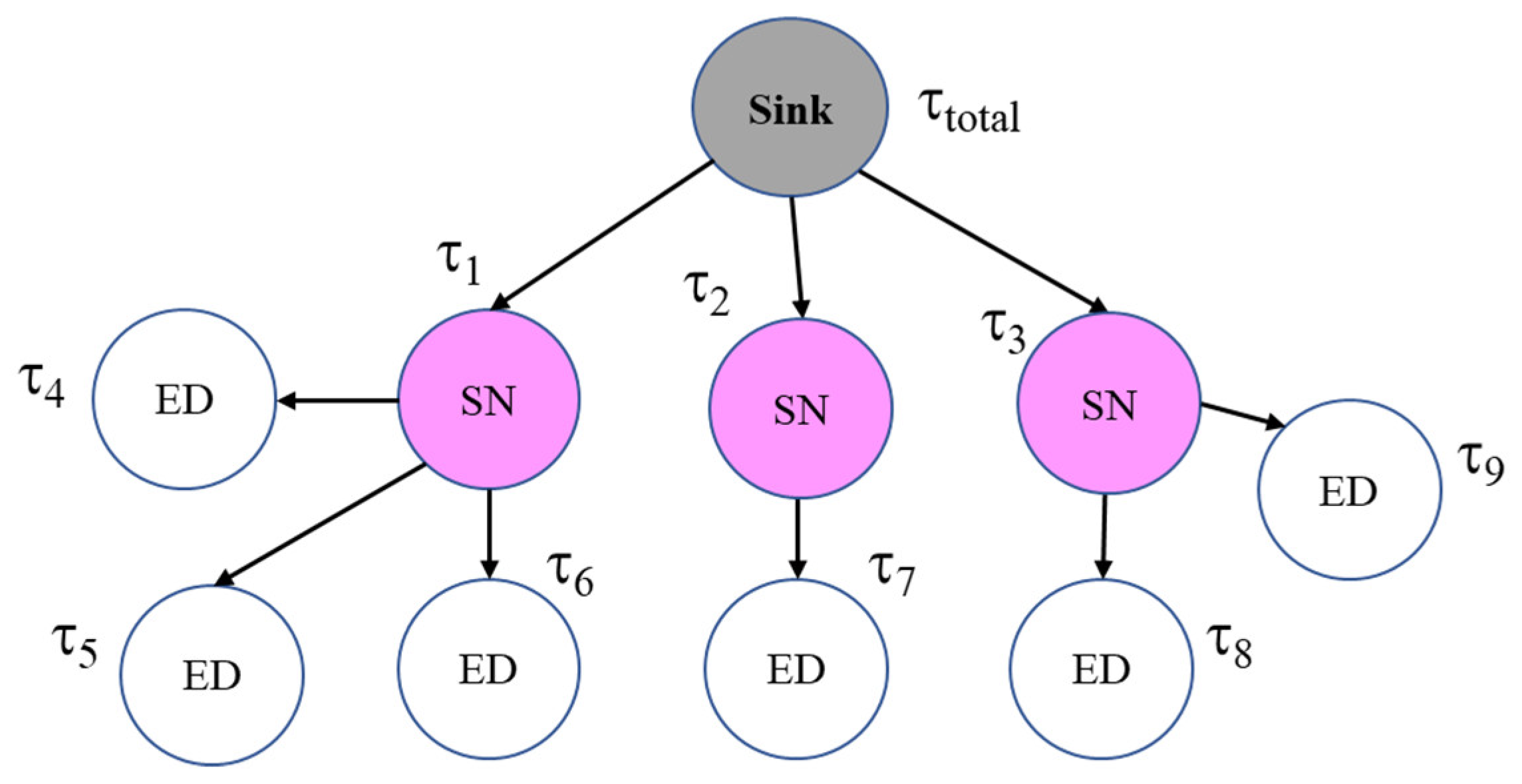


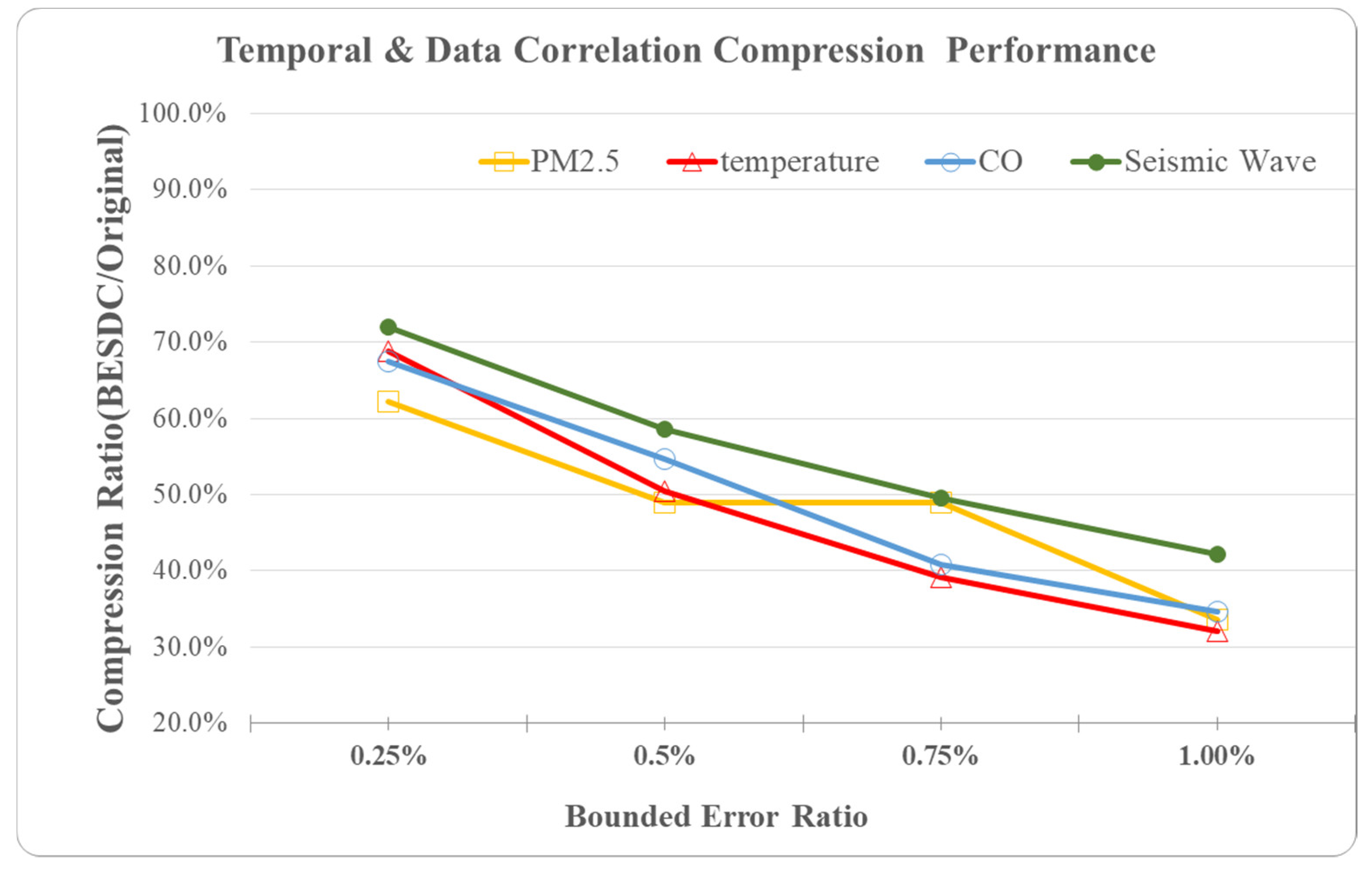
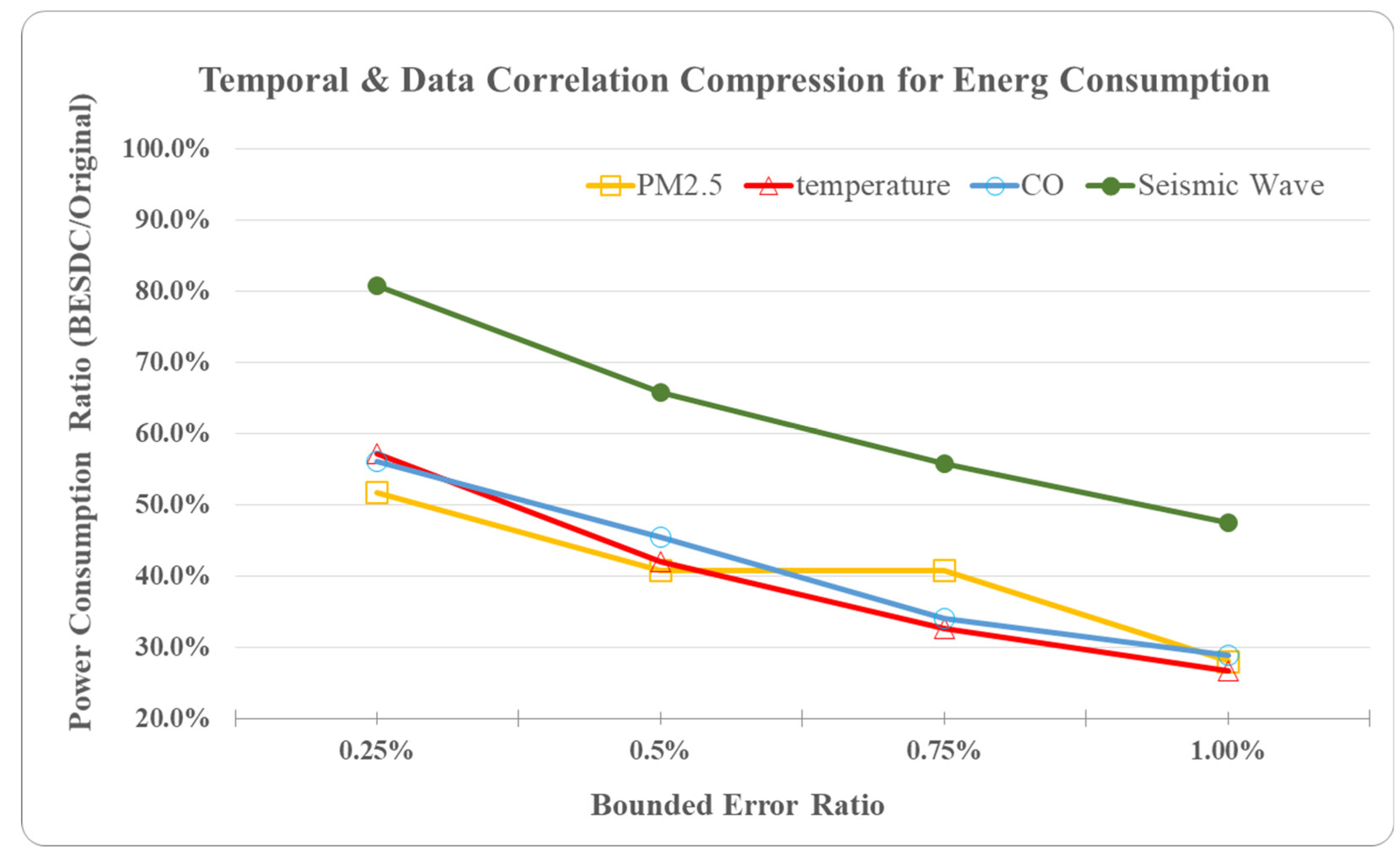
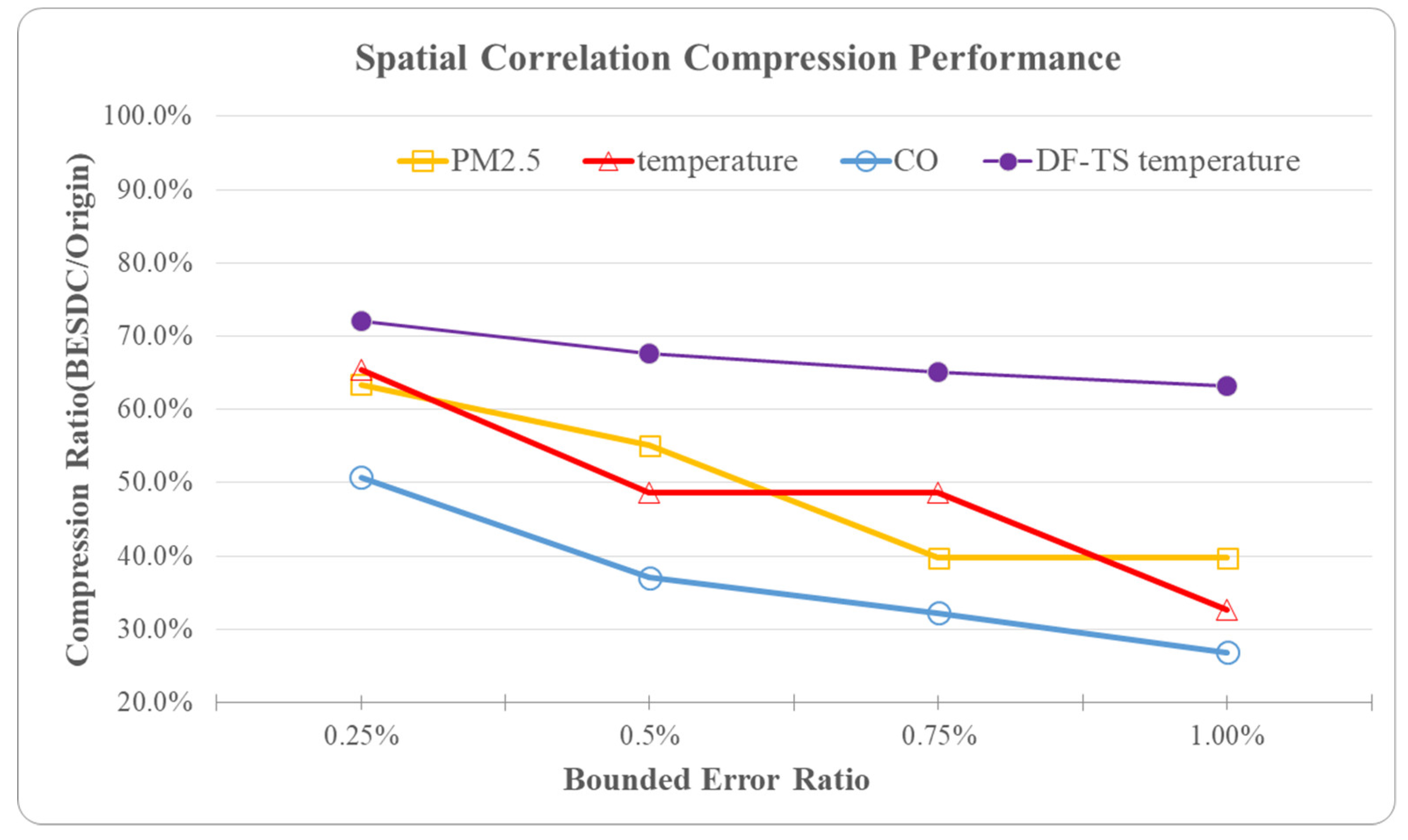
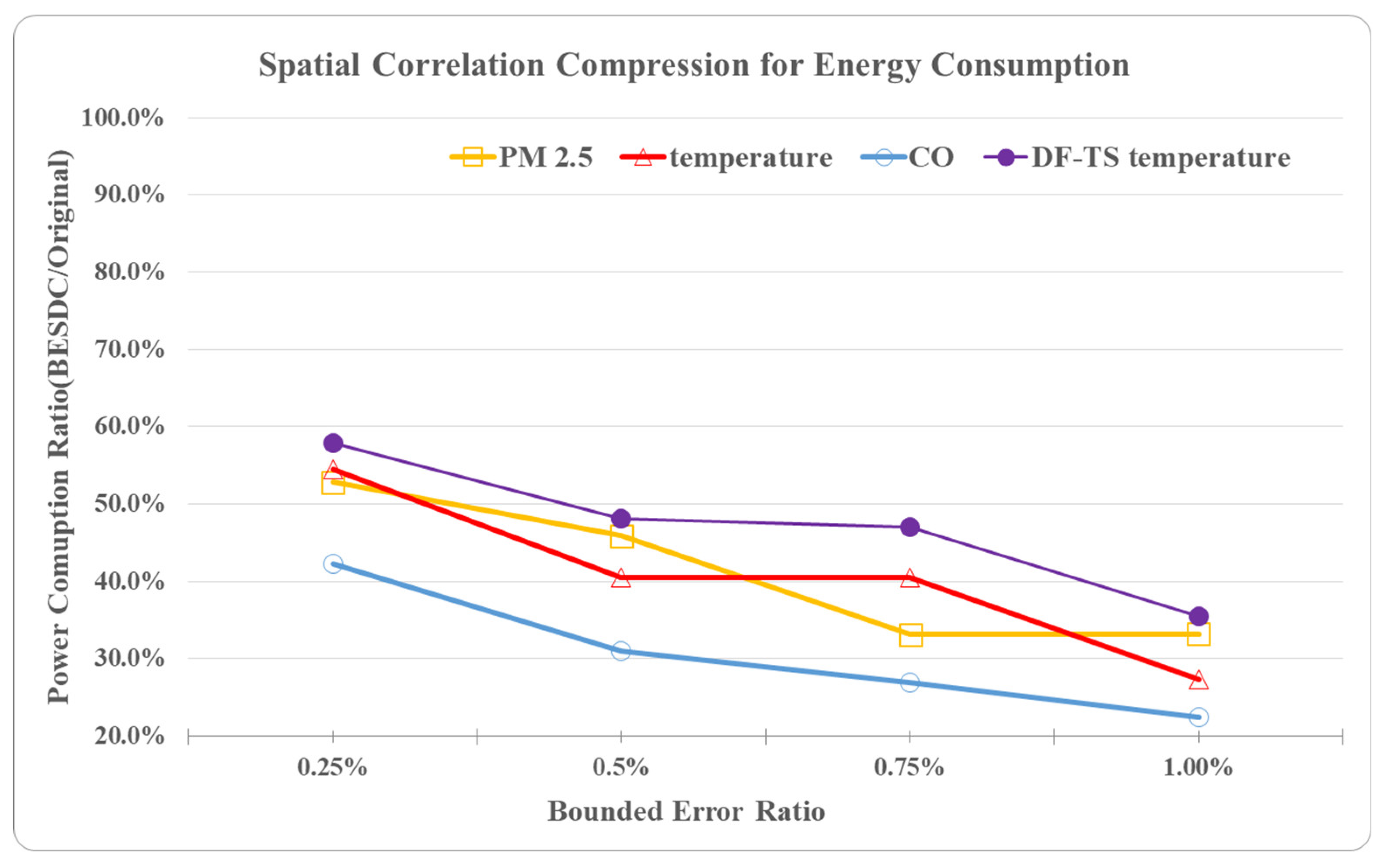

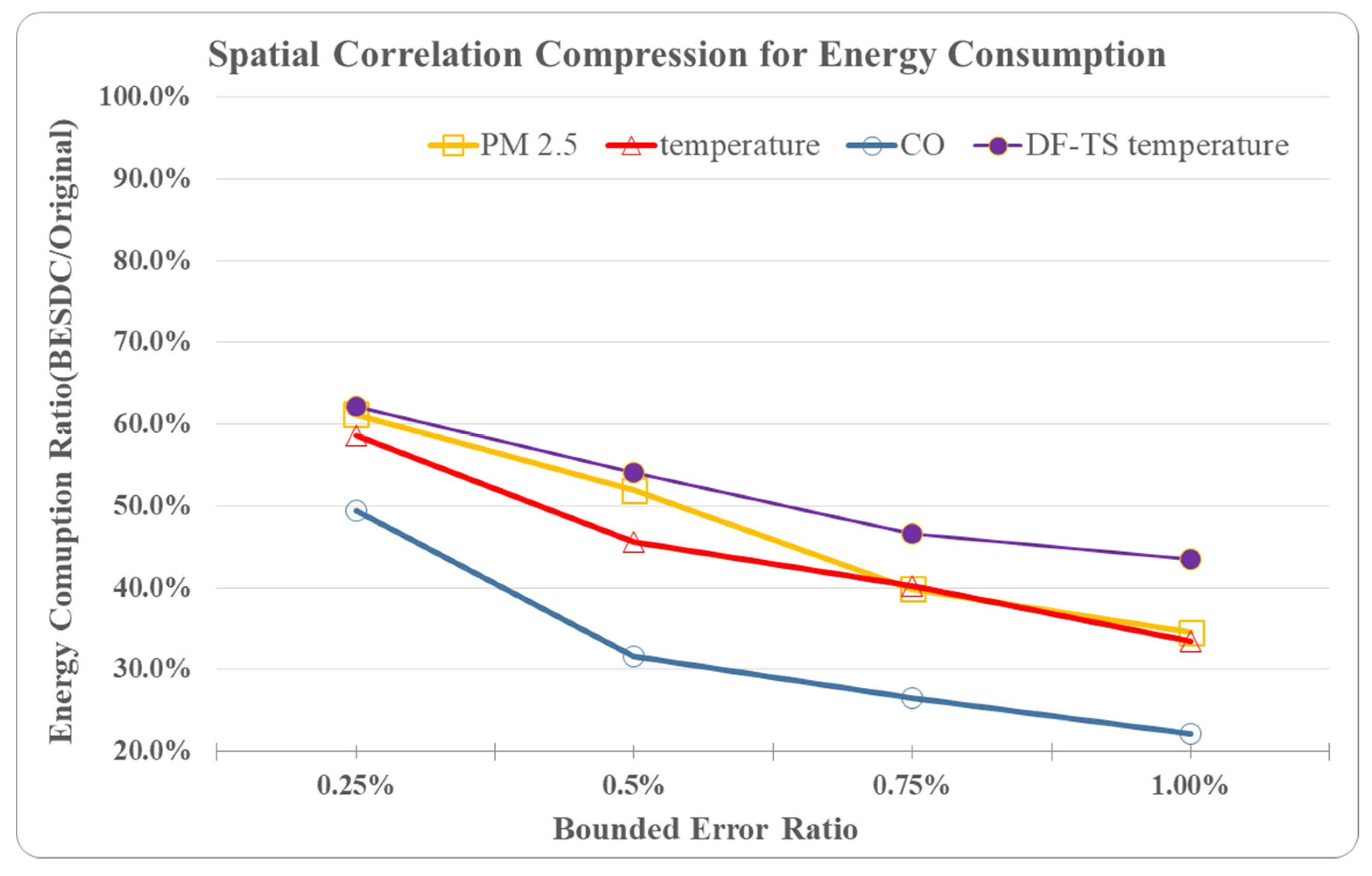
| Type | Correlation (Temporal, Spatial) | Samples | Frequency | Date Collected | |
|---|---|---|---|---|---|
| 1 | Temperature | High, High | 8760 | 1 sample/h. | 2018 |
| 2 | PM 2.5 | High, Low | 8760 | 1 sample/h. | 2018 |
| 3 | CO | High, Low | 8760 | 1 sample/h. | 2018 |
| 4 | Seismic Wave | Low, Low | 10,000 | 10 samples/s. | 21 September 1999 |
| Parameter | ITX | IRV | Icpu | fcpu | TTX | TRV | VTX | VRV | εadd | εmul | εcmp | εshf |
|---|---|---|---|---|---|---|---|---|---|---|---|---|
| Value | 17.4 mA | 19.7 mA | 31 mA | 48 MHz | 32 μs/bit | 32 μs/bit | 3.3 V | 3.3 V | 2.13 nJ | 6.39 nJ | 2.13 nJ | 4.26 nJ |
© 2020 by the authors. Licensee MDPI, Basel, Switzerland. This article is an open access article distributed under the terms and conditions of the Creative Commons Attribution (CC BY) license (http://creativecommons.org/licenses/by/4.0/).
Share and Cite
Chang, R.-I.; Chu, Y.-H.; Wei, L.-C.; Wang, C.-H. Bounded-Error-Pruned Sensor Data Compression for Energy-Efficient IoT of Environmental Intelligence. Appl. Sci. 2020, 10, 6512. https://doi.org/10.3390/app10186512
Chang R-I, Chu Y-H, Wei L-C, Wang C-H. Bounded-Error-Pruned Sensor Data Compression for Energy-Efficient IoT of Environmental Intelligence. Applied Sciences. 2020; 10(18):6512. https://doi.org/10.3390/app10186512
Chicago/Turabian StyleChang, Ray-I., Yu-Hsien Chu, Lien-Chen Wei, and Chia-Hui Wang. 2020. "Bounded-Error-Pruned Sensor Data Compression for Energy-Efficient IoT of Environmental Intelligence" Applied Sciences 10, no. 18: 6512. https://doi.org/10.3390/app10186512
APA StyleChang, R.-I., Chu, Y.-H., Wei, L.-C., & Wang, C.-H. (2020). Bounded-Error-Pruned Sensor Data Compression for Energy-Efficient IoT of Environmental Intelligence. Applied Sciences, 10(18), 6512. https://doi.org/10.3390/app10186512






